technical data SKODA YETI 2010 1.G / 5L Owner's Manual
[x] Cancel search | Manufacturer: SKODA, Model Year: 2010, Model line: YETI, Model: SKODA YETI 2010 1.G / 5LPages: 271, PDF Size: 14.71 MB
Page 218 of 271

Wheels and Tyres217
Using the system
Safety
Driving Tips
General Maintenance
Breakdown assistance
Technical Data
The tyre inflation pressure for tyres of
the tyre size 205/50 R17 or 205/55 R16, which
are intended to be used with snow chains, is identical to the tyre inflation pressure for
tyres of the tyre size 225/45 R17 or 215/60 R16, see page 216, fig. 170 .
The tyre pressure should be at the highest pressure specified for your vehicle at all
times.
Always check the inflation pressure of tyres when cold. Do not reduce the higher pres-
sure of warm tyres. Adapt the inflation pressure of the tyres accordingly if your vehicle
is carrying a significantly higher payload.
Driving style
Fast cornering, sharp acceleration and brak ing (squealing tyres) increase wear-and-
tear on your tyres.
Balancing wheels
The wheels of a new vehicle are balanced. There are a wide range of influences when
driving which may result in an imbalance and which makes themselves felt through
vibration in the steering.
You should have the wheels rebalanced si nce any imbalance increases wear-and-tear
on the steering, the suspension and tyres. A wheel must also be rebalanced when a
new tyre is fitted and each time a tyre is repaired.
Wheel alignment errors
Incorrect wheel alignment at the front and re ar will not only increase wear-and-tear on
the tyres but will also has an adverse effect on vehicle safety. Contact your specialist
garage if you notice any unusual tyre wear.
WARNING
If the inflation pressure is too low, the tyre must perform a greater flexing
work. At higher speeds the tyre will warm up as a result of this. This can result
in tread separation and even a tyre blowout.
Immediately replace the damaged rims or tyres.
Tyres which are 6 years old or more should only be fitted in exceptional
cases and when adopting an approp riately cautious style of driving.
For the sake of the environment
Tyres which are insufficiently inflated increase your fuel consumption.Wear indicatorsThe base of the tread of the original tyres has wear indicators 1.6 mm high, installed at
right angles to the direction of travel. These wear indicators are located at 6 - 8 points
depending on the make and are evenly spaced around the circumference of the tyre
fig. 171 . Markings on the walls of the tyres through the letters “TWI”, triangular
symbols or other symbols identify th e position of the wear indicators.
A remaining tread of just 1.6 mm, measured in the grooves of the tread next to the wear
indicators, means that your tyres have reached their legally permissible minimum
tread depth.
WARNING
You must have your tyres replaced with new ones at the latest when the
wear indicators have been worn down . The legally permissible minimum tread
depth should be observed.
Worn tyres do not provide the necessary adhesion to the road surface at
high speeds on wet roads. One could experience “aquaplaning” (uncontrolled
movements of the vehicle - “swimming” on a wet road surface).
Fig. 171 Tyre tread with wear indicators
s2ug.6.book Page 217 Friday, April 9, 2010 2:24 PM
Page 220 of 271
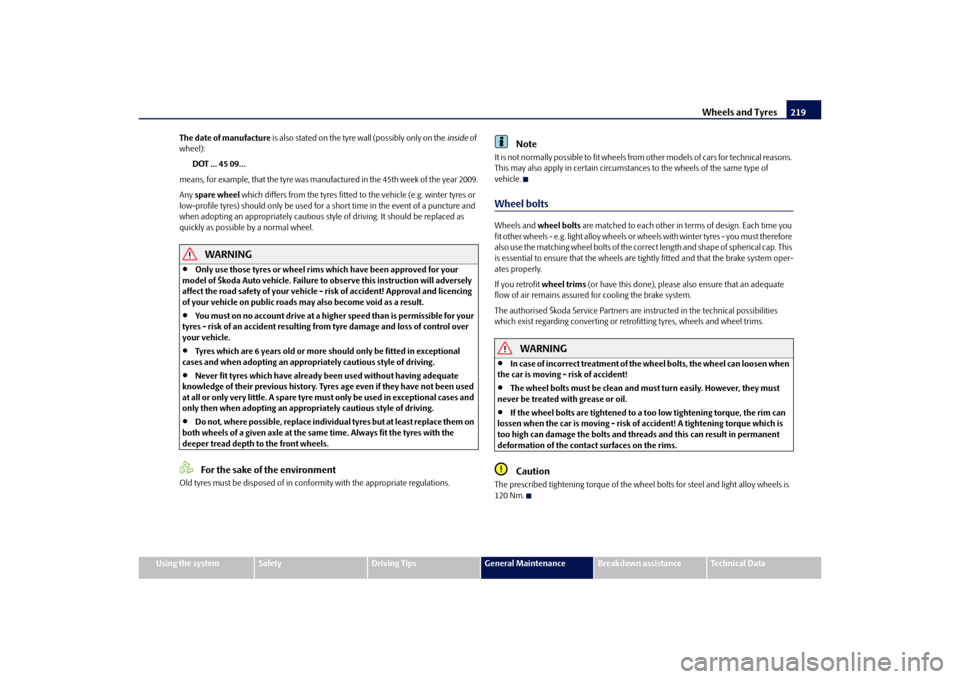
Wheels and Tyres219
Using the system
Safety
Driving Tips
General Maintenance
Breakdown assistance
Technical Data
The date of manufacture
is also stated on the tyre wall (possibly only on the inside of
wheel):
DOT ... 45 09...
means, for example, that the tyre was ma nufactured in the 45th week of the year 2009.
Any spare wheel which differs from the tyres fitted to the vehicle (e.g. winter tyres or
low-profile tyres) should only be used for a short time in the event of a puncture and
when adopting an appropriately cautious styl e of driving. It should be replaced as
quickly as possible by a normal wheel.
WARNING
Only use those tyres or wheel rims which have been approved for your
model of Škoda Auto vehicle. Failure to observe this instruction will adversely
affect the road safety of your vehicle - risk of accident! Approval and licencing
of your vehicle on public roads may also become void as a result.
You must on no account drive at a high er speed than is permissible for your
tyres - risk of an accident resulting from tyre damage and loss of control over
your vehicle.
Tyres which are 6 years old or more should only be fitted in exceptional
cases and when adopting an approp riately cautious style of driving.
Never fit tyres which have already been used without having adequate
knowledge of their previous history. Tyre s age even if they have not been used
at all or only very little. A spare tyre must only be used in exceptional cases and
only then when adopting an appropriately cautious style of driving.
Do not, where possible, replace individu al tyres but at least replace them on
both wheels of a given axle at the same time. Always fit the tyres with the
deeper tread depth to the front wheels.For the sake of the environment
Old tyres must be disposed of in conf ormity with the appropriate regulations.
Note
It is not normally possible to fit wheels from other models of cars for technical reasons.
This may also apply in certain circumstances to the wheels of the same type of
vehicle.Wheel boltsWheels and wheel bolts are matched to each other in terms of design. Each time you
fit other wheels - e.g. light alloy wheels or wheels with winter tyres - you must therefore
also use the matching wheel bolts of the corr ect length and shape of spherical cap. This
is essential to ensure that the wheels are tightly fitted and that the brake system oper-
ates properly.
If you retrofit wheel trims (or have this done), please also ensure that an adequate
flow of air remains assured for cooling the brake system.
The authorised Škoda Service Partners are instructed in the technical possibilities
which exist regarding converting or retrofitting tyres, wheels and wheel trims.
WARNING
In case of incorrect treatment of the wheel bolts, the wheel can loosen when
the car is moving - risk of accident!
The wheel bolts must be clean and must turn easily. However, they must
never be treated with grease or oil.
If the wheel bolts are tightened to a too low tightening torque, the rim can
lossen when the car is moving - risk of accident! A tightening torque which is
too high can damage the bolts and threads and this can result in permanent
deformation of the contac t surfaces on the rims.Caution
The prescribed tightening torque of the wh eel bolts for steel and light alloy wheels is
120 Nm.
s2ug.6.book Page 219 Friday, April 9, 2010 2:24 PM
Page 222 of 271

Wheels and Tyres221
Using the system
Safety
Driving Tips
General Maintenance
Breakdown assistance
Technical Data
Valid for vehicles wi
th four-wheel drive
Snow chains can be used on the front wheels as on vehicles with front-wheel drive.
page 220, “Valid for vehicles with front-wheel drive”.
In order to increase the traction (start-up pr operties), the use of snow chains is also
technically permissible on the rear axle (this means on the front and rear axle at the
same time) for the following wheel/tyre combinations:
The use of snow chains is only technically pe rmissible on the rear axle for the following
standard wheel/tyre combinations:
When fitting snow chains on the front and rear axle at the same time, the maximum
speed is limited to 50 km/h.
Only fit snow chains with links and locks not larger than 12 mm.
Remove the full wheel trims if you wish to fit snow chains to the wheels.
Take note of the various national legal provisions regarding the maximum permissible
speed of the vehicle fitted with snow chains and the limit of the maximum speed which
is recommended by the manufacturer of the snow chains.
WARNING
Please pay attention to the information in the supplied fitting instructions of
the snow chain manufacturer.
Caution
You must take the chains off as soon as you drive on roads which are free of snow. They
adversely affect the handling of your vehicle, damage the tyres and are rapidly
destroyed.
Note
We recommend that you use snow chains from the Škoda genuine accessories.
Wheel size
Depth (D)
Ty re s i z e
6J x 16
50 mm
205/55
7J x 16
45 mm
205/55
6J x 17
45 mm
205/50
Wheel size
Depth (D)
Ty re s i z e
6J x 16
50 mm
205/55
7J x 16
45 mm
205/55
6J x 17
45 mm
205/50
Wheel size
Depth (D)
Ty re s i z e
7J x 16
45 mm
215/60
7J x 17
45 mm
225/50
s2ug.6.book Page 221 Friday, April 9, 2010 2:24 PM
Page 224 of 271
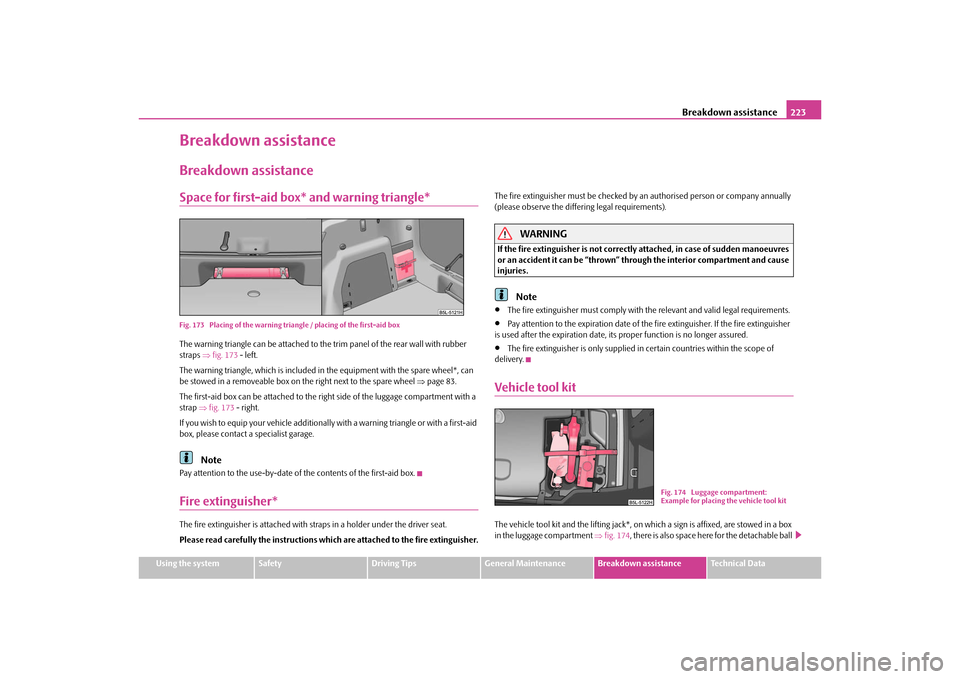
Breakdown assistance223
Using the system
Safety
Driving Tips
General Maintenance
Breakdown assistance
Technical Data
Breakdown assistanceBreakdown assistanceSpace for first-aid box* and warning triangle*Fig. 173 Placing of the warning triangle / placing of the first-aid boxThe warning triangle can be attached to th e trim panel of the rear wall with rubber
straps fig. 173 - left.
The warning triangle, which is included in the equipment with the spare wheel*, can
be stowed in a removeable box on the right next to the spare wheel page 83.
The first-aid box can be attached to the ri ght side of the luggage compartment with a
strap fig. 173 - right.
If you wish to equip your vehi cle additionally with a warning triangle or with a first-aid
box, please contact a specialist garage.
Note
Pay attention to the use-by-date of the contents of the first-aid box.Fire extinguisher*The fire extinguisher is attached with st raps in a holder under the driver seat.
Please read carefully the instructions whic h are attached to the fire extinguisher. The fire extinguisher must be checked by
an authorised person or company annually
(please observe the differing legal requirements).
WARNING
If the fire extinguisher is not correctly attached, in case of sudden manoeuvres
or an accident it can be “thrown” through the interior compartment and cause
injuries.
Note
The fire extinguisher must comply with the relevant and valid legal requirements.
Pay attention to the expiration date of the fire extinguisher. If the fire extinguisher
is used after the expiration date, its proper function is no longer assured.
The fire extinguisher is only supplied in certain countries within the scope of
delivery.
Vehicle tool kitThe vehicle tool kit and the lifting jack*, on which a sign is affixed, are stowed in a box
in the luggage compartment fig. 174 , there is also space here for the detachable ball
Fig. 174 Luggage compartment:
Example for placing the vehicle tool kit
s2ug.6.book Page 223 Friday, April 9, 2010 2:24 PM
Page 226 of 271

Breakdown assistance225
Using the system
Safety
Driving Tips
General Maintenance
Breakdown assistance
Technical Data
Changing a wheelPreliminary workThe following steps should be carried ou t before actually changing the wheel.
– If it is necessary to change a wheel, park the vehicle as far away as possible from
the traffic flow. The place you choose should be level.
–Have all the occupants get out. While changing a wheel, the occupants of the
vehicle should not stand on the road (e.g. behind a crash barrier).
– Apply the handbrake firmly.
–Engage 1st gear or if your vehicle is fitted with an automatic gearbox, position the
selector lever into position P .
– If a trailer is coupled, uncouple it.
–Take the vehicle tool kit page 223 and the spare wheel* page 224 out of the
luggage compartment.
WARNING
If you find yourself in flowing traffic switch on the hazard warning lights
system and place the warning triangle on the side of the road at the prescribed
distance from your vehicle while observing all national legal provisions. In this
way you are protecting not only yourself but also other road users.
Never start the engine with the vehicle si tting on the raised jack - danger of
suffering injury.Caution
If you have to change a wheel on a slope first block the opposite wheel with a stone or
similar object in order to secure the vehicle from unexpectedly rolling away.
Note
Comply with the national legal regulations.
Changing a wheelAlways change a wheel on a level surface as far as possible.
– Take off the full wheel trim* page 226 or the wheel trim cap page 227 or the
caps page 226.
– In the case of light alloy wheels remove the wheel trim cap page 227.
– First of all slacken the safety wheel bolt * and afterwards the other wheel bolts page 227.
– Jack up the vehicle until the wheel to be changed is clear of the ground
page 227.
– Unscrew the wheel bolts and place them on a clean surface (cloth, paper etc.).
– Take off the wheel.
– Fit on the spare wheel and tighten the wheel bolts slightly.
– Lower the car.
– Tighten the wheel bolts firmly, alternatel y and diagonally using the wheel wrench
(crosswise) and last the safety wheel bolt* page 227.
– Mount the full wheel trim/wheel trim cap or the caps.
Note
All bolts must be clean and must turn easily.
You must never grease or oil the wheel bolts!
When fitting on unidirectiona l tyres, ensure that the tyres rotate in the correct
direction page 216.
Subsequent stepsAfter changing the wheel, you mu st perform the following steps.
– Stow and attach the replaced wheel in the spare wheel well using a special screw
page 224, fig. 175.
– Stow the vehicle tool kit in the space provided.
– Check the tyre pressure on the spare wheel just mounted as soon as possible.
s2ug.6.book Page 225 Friday, April 9, 2010 2:24 PM
Page 228 of 271
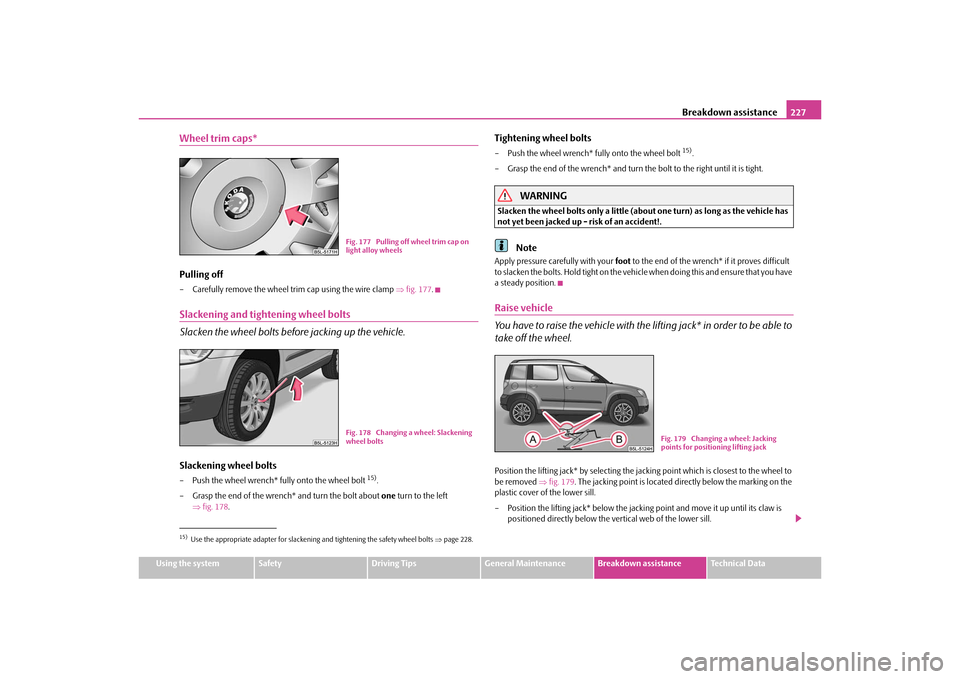
Breakdown assistance227
Using the system
Safety
Driving Tips
General Maintenance
Breakdown assistance
Technical Data
Wheel trim caps*Pulling off– Carefully remove the wheel tr im cap using the wire clamp fig. 177 .Slackening and tightening wheel bolts
Slacken the wheel bolts befo re jacking up the vehicle.Slackening wheel bolts– Push the wheel wrench* fully onto the wheel bolt
15).
– Grasp the end of the wrench* and turn the bolt about one turn to the left
fig. 178 .
Tightening wheel bolts– Push the wheel wrench* fully onto the wheel bolt
15).
– Grasp the end of the wrench* and turn the bolt to the right until it is tight.
WARNING
Slacken the wheel bolts only a little (about one turn) as long as the vehicle has
not yet been jacked up - risk of an accident!.
Note
Apply pressure carefully with your foot to the end of the wrench* if it proves difficult
to slacken the bolts. Hold tight on the vehicl e when doing this and ensure that you have
a steady position.Raise vehicle
You have to raise the vehicle with the lifting jack* in order to be able to
take off the wheel.Position the lifting jack* by selecting the ja cking point which is closest to the wheel to
be removed fig. 179. The jacking point is located directly below the marking on the
plastic cover of the lower sill.
– Position the lifting jack* be low the jacking point and move it up until its claw is
positioned directly below the vertical web of the lower sill.
15)Use the appropriate adapter for slackening and tightening the safety wheel bolts page 228.
Fig. 177 Pulling off wheel trim cap on
light alloy wheelsFig. 178 Changing a wheel: Slackening
wheel bolts
Fig. 179 Changing a wheel: Jacking
points for positioning lifting jack
s2ug.6.book Page 227 Friday, April 9, 2010 2:24 PM
Page 230 of 271
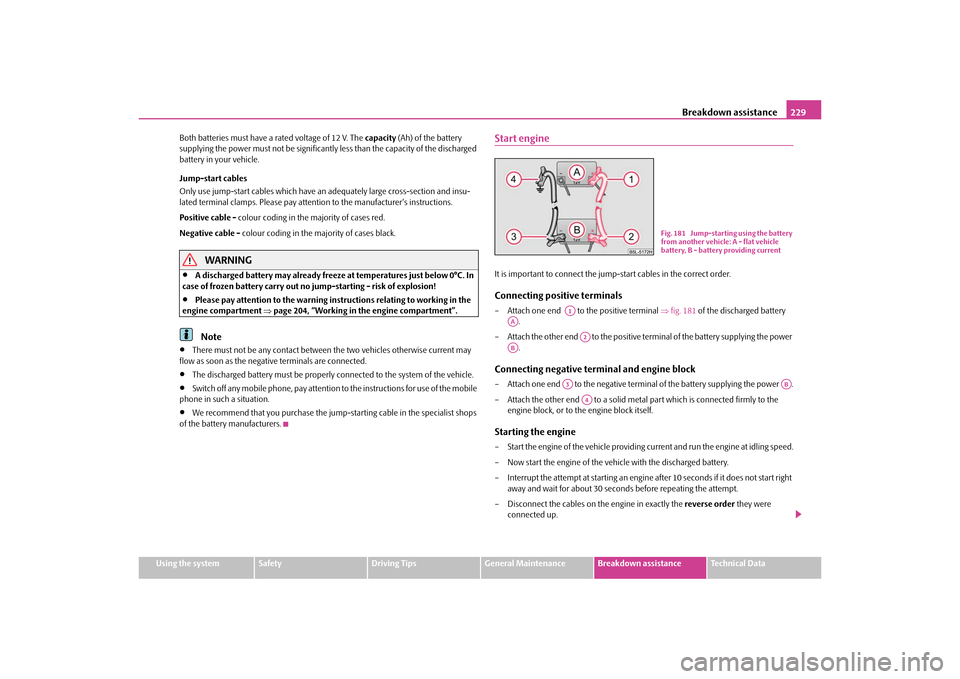
Breakdown assistance229
Using the system
Safety
Driving Tips
General Maintenance
Breakdown assistance
Technical Data
Both batteries must have a rated voltage of 12 V. The
capacity (Ah) of the battery
supplying the power must not be significantly less than the capacity of the discharged
battery in your vehicle.
Jump-start cables
Only use jump-start cables which have an adequately large cross-section and insu-
lated terminal clamps. Plea se pay attention to the manufacturer's instructions.
Positive cable - colour coding in the majority of cases red.
Negative cable - colour coding in the majority of cases black.
WARNING
A discharged battery may already freeze at temperatures just below 0°C. In
case of frozen battery carry out no jump-starting - risk of explosion!
Please pay attention to the warning instructions relating to working in the
engine compartment page 204, “Working in the engine compartment”.Note
There must not be any contact between the two vehicles otherwise current may
flow as soon as the negati ve terminals are connected.
The discharged battery must be properly connected to the system of the vehicle.
Switch off any mobile phone, pay attention to the instructions for use of the mobile
phone in such a situation.
We recommend that you purchase the jump-starting cable in the specialist shops
of the battery manufacturers.
Start engineIt is important to connect the jump-start cables in the correct order.Connecting positive terminals– Attach one end to the positive terminal fig. 181 of the discharged battery
.
– Attach the other end to the positive te rminal of the battery supplying the power
.Connecting negative term inal and engine block– Attach one end to the negative termin al of the battery supplying the power .
– Attach the other end to a solid metal part which is connected firmly to the
engine block, or to the engine block itself.Starting the engine– Start the engine of the vehicle providing current and run the engine at idling speed.
– Now start the engine of the vehicle with the discharged battery.
– Interrupt the attempt at starting an engine after 10 seconds if it does not start right away and wait for about 30 seconds before repeating the attempt.
– Disconnect the cables on the engine in exactly the reverse order they were
connected up.
Fig. 181 Jump-starting using the battery
from another vehicle: A - flat vehicle
battery, B - battery providing current
A1
AA
A2
AB
A3
AB
A4
s2ug.6.book Page 229 Friday, April 9, 2010 2:24 PM
Page 232 of 271
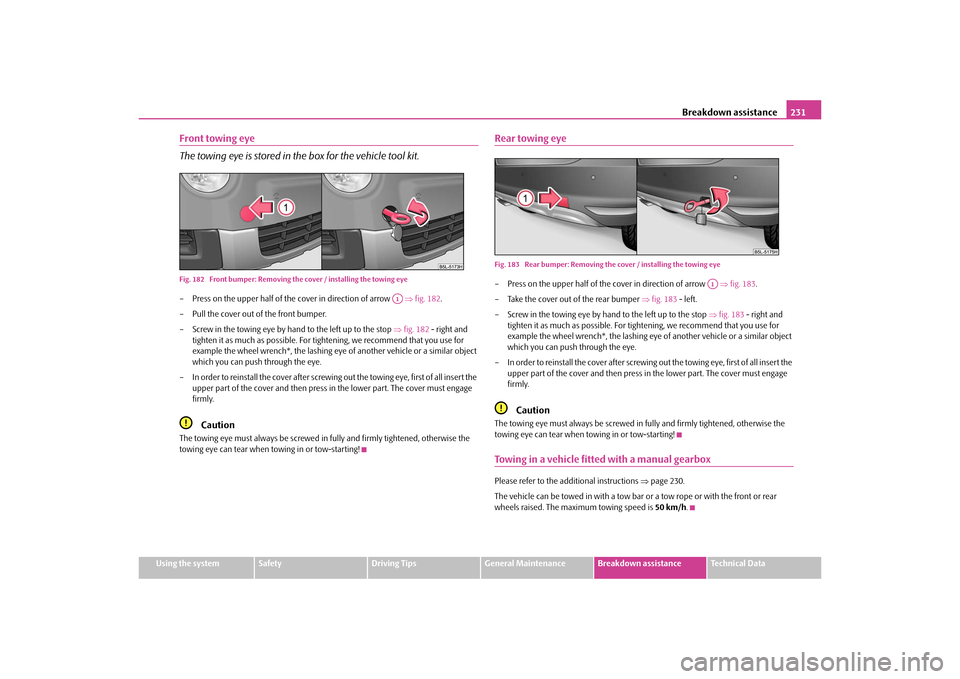
Breakdown assistance231
Using the system
Safety
Driving Tips
General Maintenance
Breakdown assistance
Technical Data
Front towing eye
The towing eye is stored in the box for the vehicle tool kit.Fig. 182 Front bumper: Removing the cover / installing the towing eye– Press on the upper half of the cover in direction of arrow fig. 182 .
– Pull the cover out of the front bumper.
– Screw in the towing eye by hand to the left up to the stop fig. 182 - right and
tighten it as much as possible. For ti ghtening, we recommend that you use for
example the wheel wrench*, the lashing eye of another vehicle or a similar object
which you can push through the eye.
– In order to reinstall the cover after screwing out the towing eye, first of all insert the upper part of the cover and then press in the lower part. The cover must engage
firmly.
Caution
The towing eye must always be screwed in fully and firmly tightened, otherwise the
towing eye can tear when to wing in or tow-starting!
Rear towing eyeFig. 183 Rear bumper: Removing the cover / installing the towing eye– Press on the upper half of the cover in direction of arrow fig. 183 .
– Take the cover out of the rear bumper fig. 183 - left.
– Screw in the towing eye by hand to the left up to the stop fig. 183 - right and
tighten it as much as po ssible. For tightening, we recommend that you use for
example the wheel wrench*, the lashing eye of another vehicle or a similar object
which you can push through the eye.
– In order to reinstall the cover after screwing out the towing eye, first of all insert the
upper part of the cover and then press in the lower part. The cover must engage
firmly.
Caution
The towing eye must always be screwed in fully and firmly tightened, otherwise the
towing eye can tear when towing in or tow-starting!Towing in a vehicle fitted with a manual gearboxPlease refer to the additional instructions page 230.
The vehicle can be towed in with a tow bar or a tow rope or with the front or rear
wheels raised. The maximum towing speed is 50 km/h.
A1
A1
s2ug.6.book Page 231 Friday, April 9, 2010 2:24 PM
Page 234 of 271
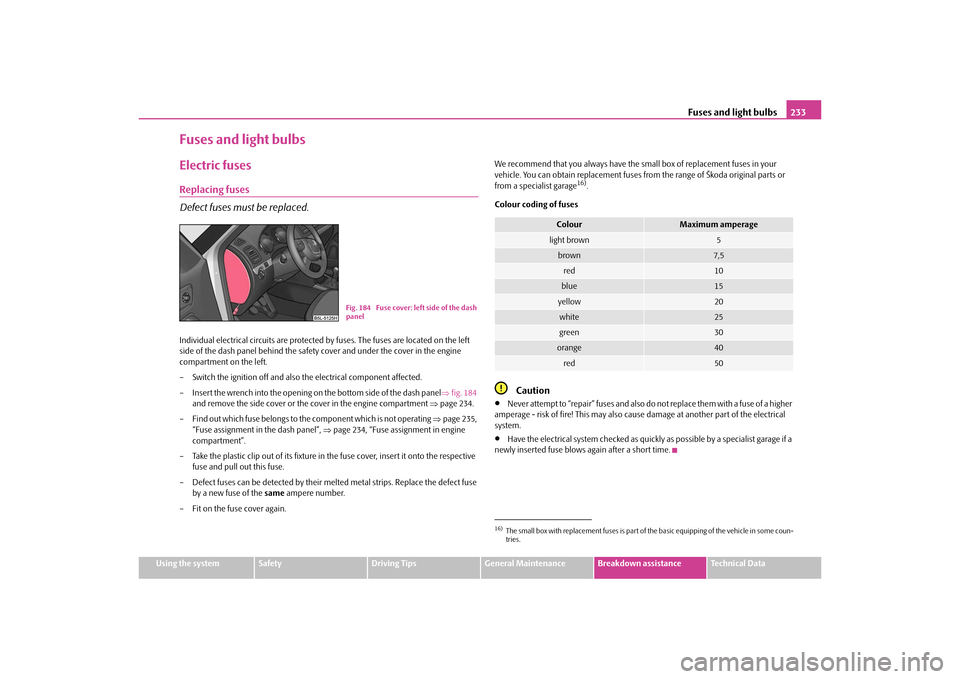
Fuses and light bulbs233
Using the system
Safety
Driving Tips
General Maintenance
Breakdown assistance
Technical Data
Fuses and light bulbsElectric fusesReplacing fuses
Defect fuses must be replaced.Individual electrical circuits are protected by fuses. The fuses are located on the left
side of the dash panel behind the safety cover and under the cover in the engine
compartment on the left.
– Switch the ignition off and also the electrical component affected.
– Insert the wrench into the opening on the bottom side of the dash panel fig. 184
and remove the side cover or the cover in the engine compartment page 234.
– Find out which fuse belongs to th e component which is not operating page 235,
“Fuse assignment in the dash panel”, page 234, “Fuse assignment in engine
compartment”.
– Take the plastic clip out of it s fixture in the fuse cover, insert it onto the respective
fuse and pull out this fuse.
– Defect fuses can be detected by their melted metal strips. Replace the defect fuse by a new fuse of the same ampere number.
– Fit on the fuse cover again. We recommend that you always have the
small box of replacement fuses in your
vehicle. You can obtain repl acement fuses from the range of Škoda original parts or
from a specialist garage
16).
Colour coding of fuses
Caution
Never attempt to “repair” fuses and also do not replace them with a fuse of a higher
amperage - risk of fire! This may also caus e damage at another part of the electrical
system.
Have the electrical system checked as quickly as possible by a specialist garage if a
newly inserted fuse blows again after a short time.
Fig. 184 Fuse cover: left side of the dash
panel
16)The small box with replacement fuses is part of the basic equipping of the vehicle in some coun-
tries.
Colour
Maximum amperage
light brown
5
brown
7,5
red
10
blue
15
yellow
20
white
25
green
30
orange
40
red
50
s2ug.6.book Page 233 Friday, April 9, 2010 2:24 PM
Page 236 of 271
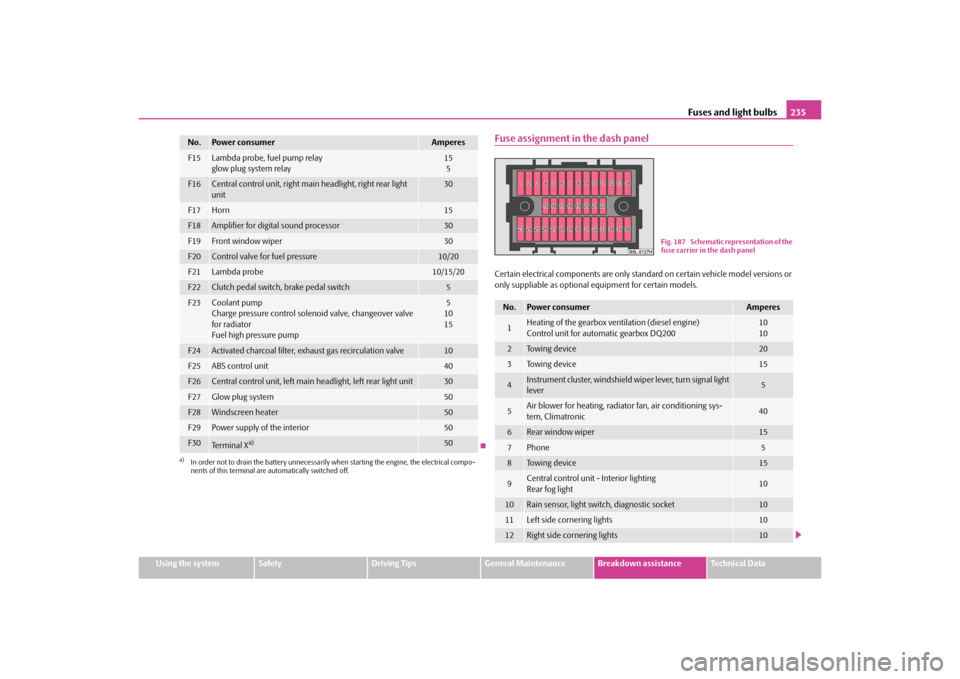
Fuses and light bulbs235
Using the system
Safety
Driving Tips
General Maintenance
Breakdown assistance
Technical Data
Fuse assignment in the dash panelCertain electrical components are only stan dard on certain vehicle model versions or
only suppliable as optional equipment for certain models.
F15
Lambda probe, fuel pump relay
glow plug system relay
15
5
F16
Central control unit, right main headlight, right rear light
unit
30
F17
Horn
15
F18
Amplifier for digital sound processor
30
F19
Front window wiper
30
F20
Control valve for fuel pressure
10/20
F21
Lambda probe
10/15/20
F22
Clutch pedal switch, brake pedal switch
5
F23
Coolant pump
Charge pressure control solenoid valve, changeover valve
for radiator
Fuel high pressure pump
5
10
15
F24
Activated charcoal filter, ex haust gas recirculation valve
10
F25
ABS control unit
40
F26
Central control unit, left main headlight, left rear light unit
30
F27
Glow plug system
50
F28
Windscreen heater
50
F29
Power supply of the interior
50
F30
Te r m i n a l X
a)
50
a)In order not to drain the battery unnecessarily wh en starting the engine, the electrical compo-
nents of this terminal are automatically switched off.No.
Power consumer
Amperes
No.
Power consumer
Amperes
1
Heating of the gearbox ventilation (diesel engine)
Control unit for automatic gearbox DQ200
10
10
2
To w i n g d e v i c e
20
3
To w i n g d e v i c e
15
4
Instrument cluster, windshield wiper lever, turn signal light
lever
5
5
Air blower for heating, radiat or fan, air conditioning sys-
tem, Climatronic
40
6
Rear window wiper
15
7
Phone
5
8
To w i n g d e v i c e
15
9
Central control unit - Interior lighting
Rear fog light
10
10
Rain sensor, light switch, diagnostic socket
10
11
Left side cornering lights
10
12
Right side cornering lights
10
Fig. 187 Schematic representation of the
fuse carrier in the dash panel
s2ug.6.book Page 235 Friday, April 9, 2010 2:24 PM